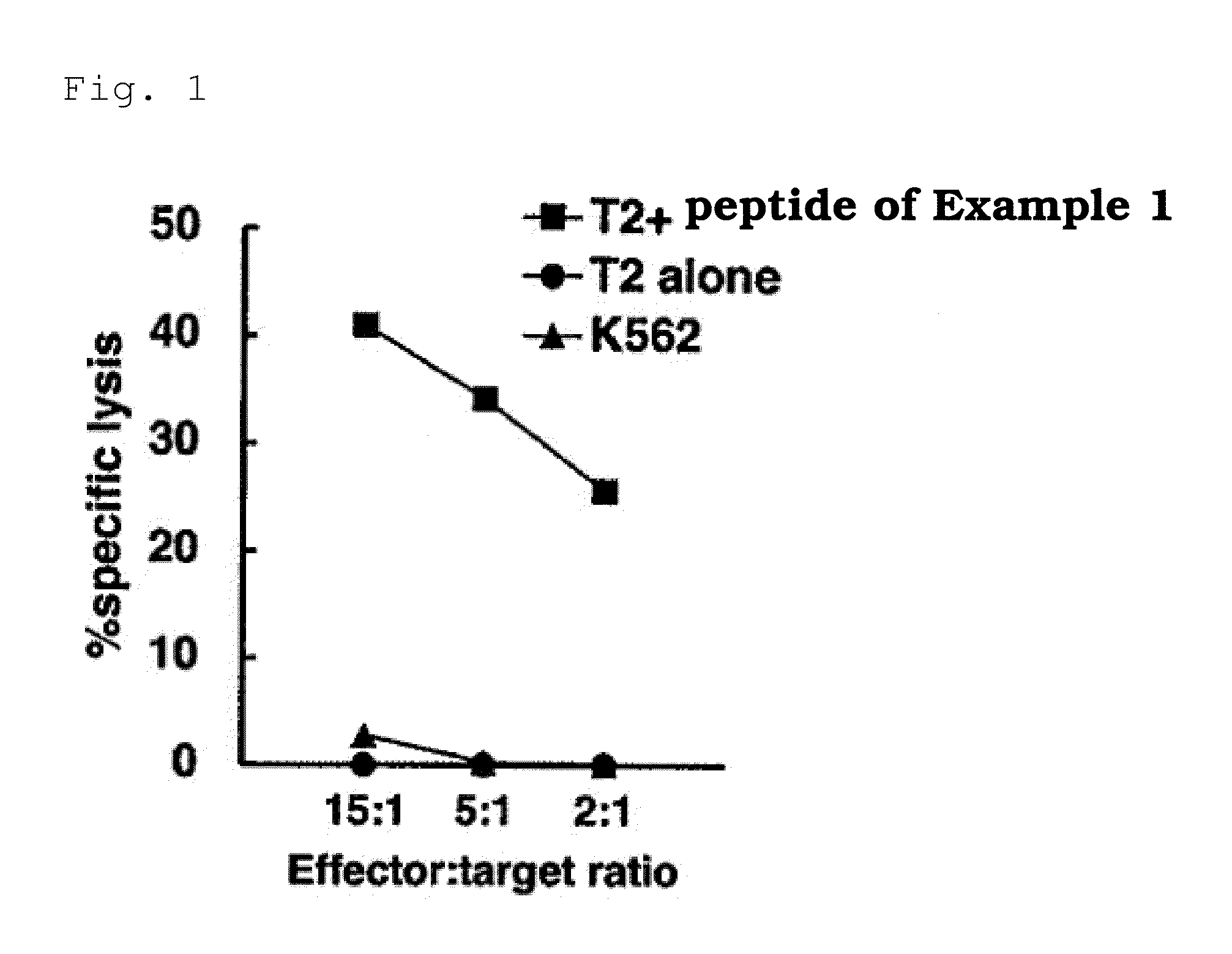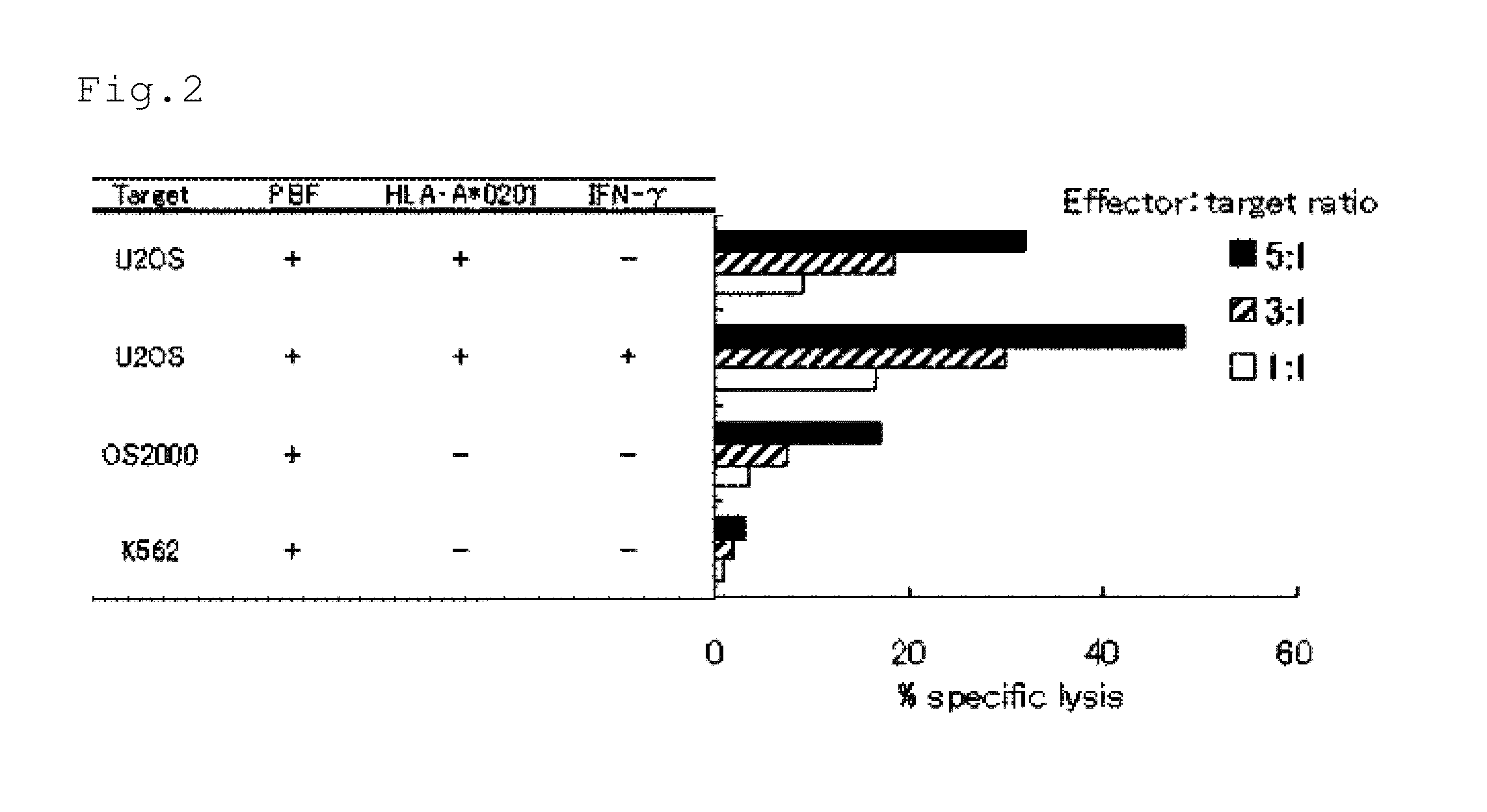Tumor antigen peptide and use thereof
a tumor-antigen peptide and antigen technology, applied in the field of tumor-antigen peptides, can solve the problems of pbf-derived tumor-antigen peptides which bind and antigens have not been found
- Summary
- Abstract
- Description
- Claims
- Application Information
AI Technical Summary
Benefits of technology
Problems solved by technology
Method used
Image
Examples
example 1
Synthesis of Peptides and Measurement of their Binding Affinity to HLA-A 0201
[0124]A peptide shown in SEQ ID NO:4 was synthesized by the Fmoc method. Binding affinity of the peptide to HLA-A0201 was measured by an HLA class I stabilization assay (J Immunol, 2004, 173:1436, which is incorporated herein by reference). In the assay, a peptide derived from influenza matrix protein (RYLRDQQLLGI, SEQ ID NO:5) was used as a positive control and a murine H-2 Kb binding peptide VSV8 (RGYVYQGL, SEQ ID NO:6) was used as a negative control. The assay was performed in triplicate. The measured binding affinity to HLA-A0201 of the peptides was detected by staining with an FITC-labeled anti-HLA-A2 monoclonal antibody BB7.2 (purchased from ATCC), and measuring the fluorescence signals by a flow cytometry, and determining the percent mean fluorescence Intensity increase (% MFI increase) according to the following equation: % MFI increase=[(MFI with the given peptide−MFI without peptide) / (MFI without ...
example 2
Frequency Analysis of Antigenic Peptide-Specific CTLs
[0125]Lymphocytes from five PBF-positive patients with osteosarcoma were subjected to mixed lymphocyte peptide culture under conditions of limiting dilution (limiting dilution / mixed lymphocyte peptide culture; LD / MLPC) to induce peptide-specific CTLs (Cancer Sci., 2008, 99:368-375, which is incorporated herein by reference). Regarding two patients: Patient Nos. 1 and 2, 50 ml of peripheral blood was collected to isolate peripheral blood mononuclear cells (PBMCs). PBMCs were cultured for 60 minutes at room temperature in AIM-V medium (Invitrogen) containing 1% human serum and supplemented with 50 μg / ml of the peptide shown in SEQ ID NO:4. PBMCs which were pulsed with the peptide were plated at 2×105 cells / 200 μl / well on a U-bottomed 96-well microtiter plate and cultured in AIM-V medium containing 10% human serum, 20 U / ml IL-2, and 10 ng / ml IL-7. Seven days after the culture was started, half of the cultured medium in each well was ...
example 3
Establishing of Antigenic Peptide-Specific CTLs
[0128]For culturing T cells, B-cell line: NS-EBV-B cells, which were obtained by transforming with EB virus B cells from a healthy individual who was positive for HLA-A0201, and B-cell line: LCL-S2000 cells, which were obtained by transforming with EB virus B cells from a patient with osteosarcoma who was negative for HLA-A0201 (J Orthop Sci., 2003, 8:554-559, which is incorporated herein by reference) were used. T cells from wells of Patient No. 4 which were tetramer-positive found in Example 2 were plated at a single cell / well on a 96-well microplate. To each well were added 2×104 NS-EBV-B cells which had been irradiated and pulsed with the peptide shown in SEQ ID NO:4 and 8×104 allogenic PBMCs which had been irradiated, and cultured in 200 μl AIM-V medium containing 10% human serum, 200 U / ml IL-2, and 10 ng / ml IL-7. 14 and 21 days after the culture was started, 100 μl of the medium was replaced with a new medium containing 1×104 NS-E...
PUM
| Property | Measurement | Unit |
|---|---|---|
| Fraction | aaaaa | aaaaa |
| Fraction | aaaaa | aaaaa |
| Fraction | aaaaa | aaaaa |
Abstract
Description
Claims
Application Information
 Login to View More
Login to View More - R&D
- Intellectual Property
- Life Sciences
- Materials
- Tech Scout
- Unparalleled Data Quality
- Higher Quality Content
- 60% Fewer Hallucinations
Browse by: Latest US Patents, China's latest patents, Technical Efficacy Thesaurus, Application Domain, Technology Topic, Popular Technical Reports.
© 2025 PatSnap. All rights reserved.Legal|Privacy policy|Modern Slavery Act Transparency Statement|Sitemap|About US| Contact US: help@patsnap.com


